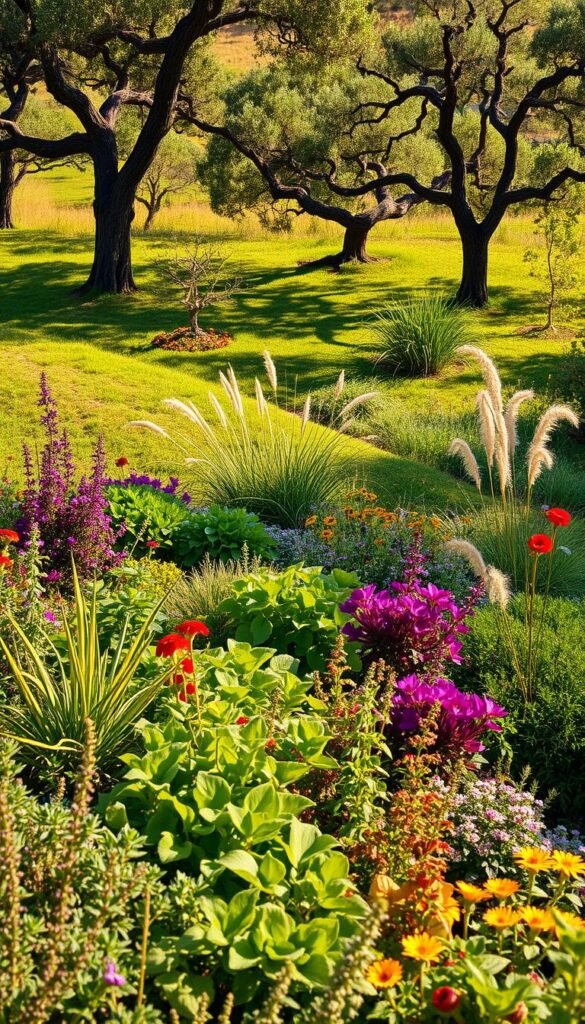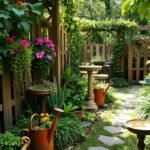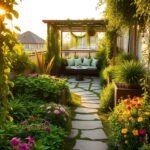Imagine stepping into a yard where every plant serves a purpose—beauty, flavor, or both. This approach redefines how we design outdoor spaces, merging practical food growth with eye-catching arrangements. Gone are the days of choosing between pretty flowers and tasty harvests.
Picture rainbow-hued leafy greens framing walkways while fragrant herbs spill over raised beds. Fruit-bearing varieties offer shade and snacks during summer months. This method cuts water use compared to grass lawns and supports local pollinators—a win for your wallet and the environment.
Families gain fresh ingredients steps from their kitchen while learning about seasonal cycles. Perennial picks like berries return yearly with little effort, letting you focus on enjoying nature’s bounty. For more ideas on elevating your outdoor area, explore our design tips that balance form and function.
This strategy isn’t just about growing food—it’s crafting living art that nourishes body and soul. Your property becomes a dynamic ecosystem where beauty and productivity thrive side by side, season after season.
Understanding Edible Landscaping for Your Outdoor Space
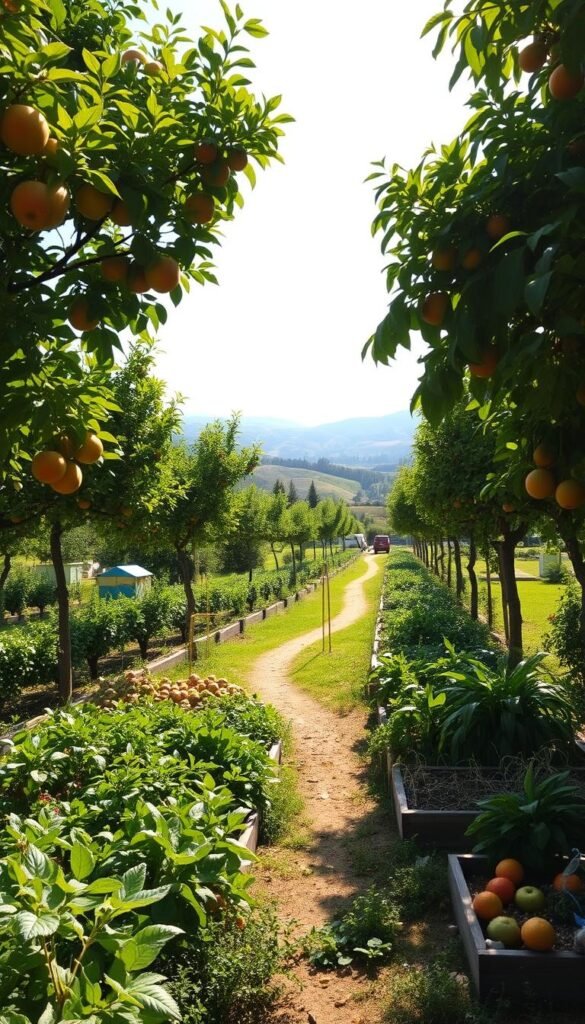
Discover how your outdoor area can become both a feast for the eyes and the table. This approach reimagines traditional layouts by weaving food production into every design element, creating spaces that nourish and delight simultaneously.
How Plants Become Living Decor
Swap generic shrubs for crimson-stemmed chard or purple basil that doubles as pesto ingredients. Flowering thyme spills over pathways with bursts of pink blooms, while dwarf citrus varieties offer glossy leaves and fragrant blossoms. These choices prove functionality doesn’t sacrifice style.
“A well-planned edible space feeds your family first, then your soul.”
Savings That Grow With You
Your grocery list shrinks as these living investments mature. A single blueberry bush yields pounds of antioxidants annually, while perennial herbs like rosemary thrive for decades. Consider these advantages:
- Cut water bills by 30% compared to turf grass
- Eliminate pesticide costs with natural pest-repelling companions like marigolds
- Enjoy organic ingredients at 10% of store prices
Beyond economics, these spaces become outdoor classrooms. Kids learn photosynthesis through strawberry growth cycles, while adults reconnect with seasonal rhythms. Your property transforms into a sanctuary where every element serves multiple purposes.
Exploring the Charm of Orchard Trees in Your Garden
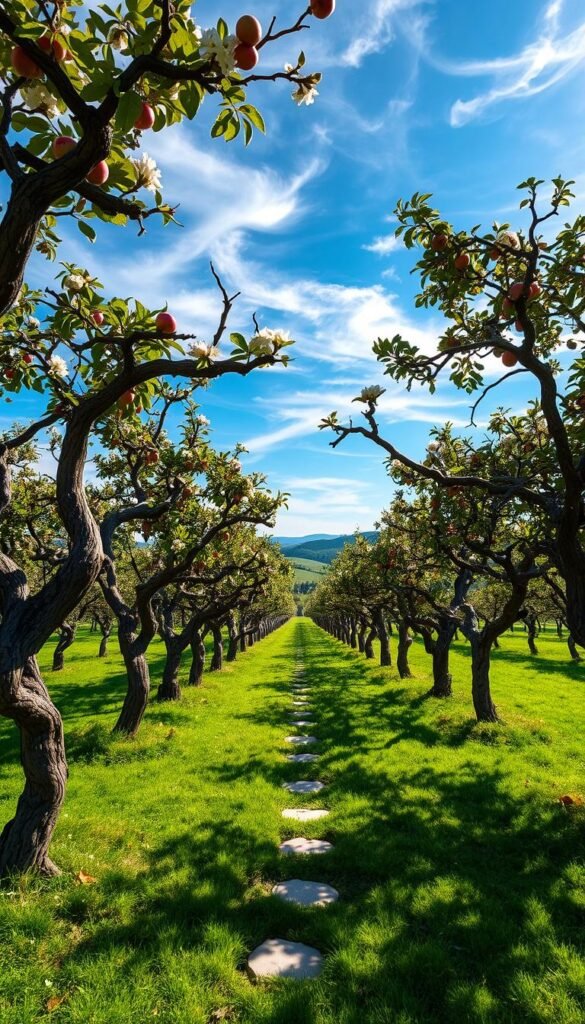
Transform your outdoor space into a living canvas where practicality meets artistry. Orchard varieties bring structure and seasonal drama while delivering fresh snacks straight from the branch. Their multi-season appeal turns ordinary yards into dynamic spaces that evolve throughout the year.
Ornamental Qualities of Fruit Trees
Dwarf apple varieties steal the show with springtime pink blooms that morph into summer’s crisp treats. Compact forms fit snugly against fences or patios, proving you don’t need acres for homegrown abundance. Japanese persimmons become winter stars when fiery orange fruits cling to bare branches like natural ornaments.
Decorative pear species offer symmetrical shapes that frame properties with elegance. Their edible yields pair beautifully with fall’s golden foliage display. For warm climates, potted citrus becomes mobile decor—glossy leaves and fragrant flowers brightening porches before yielding tangy rewards.
Integrating Functional Edible Plants
Surround your arboreal centerpieces with clever companions. Nitrogen-rich comfrey nourishes soil while lavender deters pests with its soothing scent. Strawberry ground covers suppress weeds and offer sweet bonuses during harvest months.
“The right plant partnerships turn your green space into a self-sustaining ecosystem.”
Deep-rooted yarrow mines nutrients from subsoil, sharing them with nearby fruit trees. This natural teamwork reduces maintenance while boosting yields. Even container-grown lemons thrive when paired with basil—their aromatic leaves enhancing both recipes and visual appeal.
Designing Your Edible Landscape Master Plan
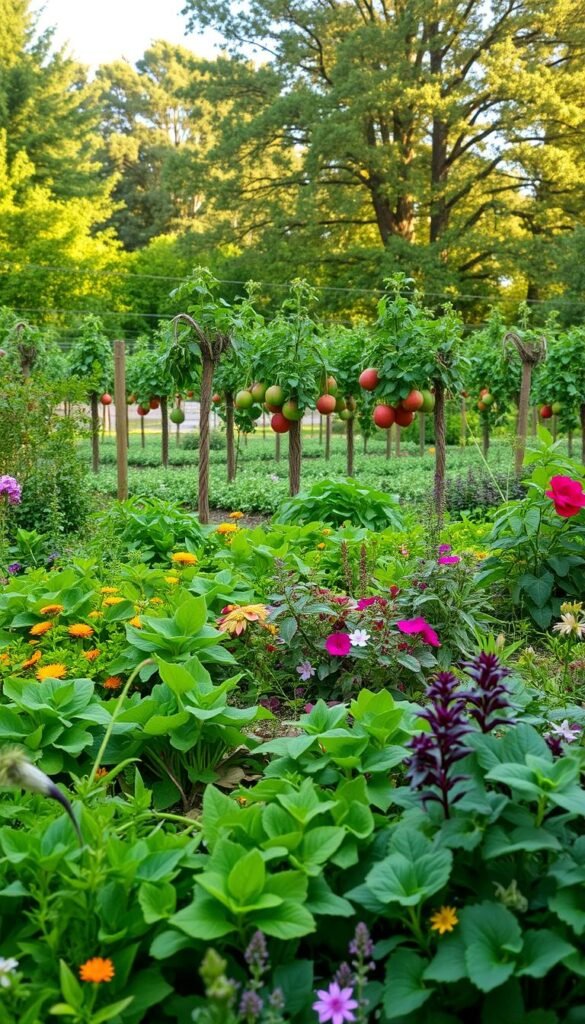
Crafting a thriving edible landscape begins with smart design choices that work through every season. Your space becomes a living calendar where colors, textures, and flavors shift with nature’s rhythm. Start by mapping sunlight patterns and water sources to match your plants’ needs.
Planning for Year-Round Interest
Layer your layout like a professional painter. Tall fruit bushes create natural backdrops, while mid-height herbs form textured middle layers. Low-growing strawberries or creeping thyme add finishing touches along borders. This approach maximizes visual depth and harvest potential.
Evergreen rosemary and sage anchor your landscaping ideas during colder months. Pair them with winter kale whose ruffled leaves catch frost like lace. Come spring, flowering quince branches erupt in coral blooms before yielding tart fruits.
“A great plan considers what your eyes taste first, then your palate.”
Group moisture-loving lettuces near rain barrels while drought-tolerant lavender thrives in sunny slopes. This zoning cuts maintenance time and boosts plant health. Add curved stone paths between beds—they guide visitors while preventing soil compaction.
Blueberry bushes deliver triple rewards: spring blossoms, summer berries, and fiery autumn leaves. Such multi-season performers keep your garden aesthetically pleasing while filling pantry shelves. With strategic placement, every inch works overtime—beauty and bounty in perfect balance.
Fruit Garden Aesthetic: Blending Orchard Trees and Vibrant Edible Landscaping
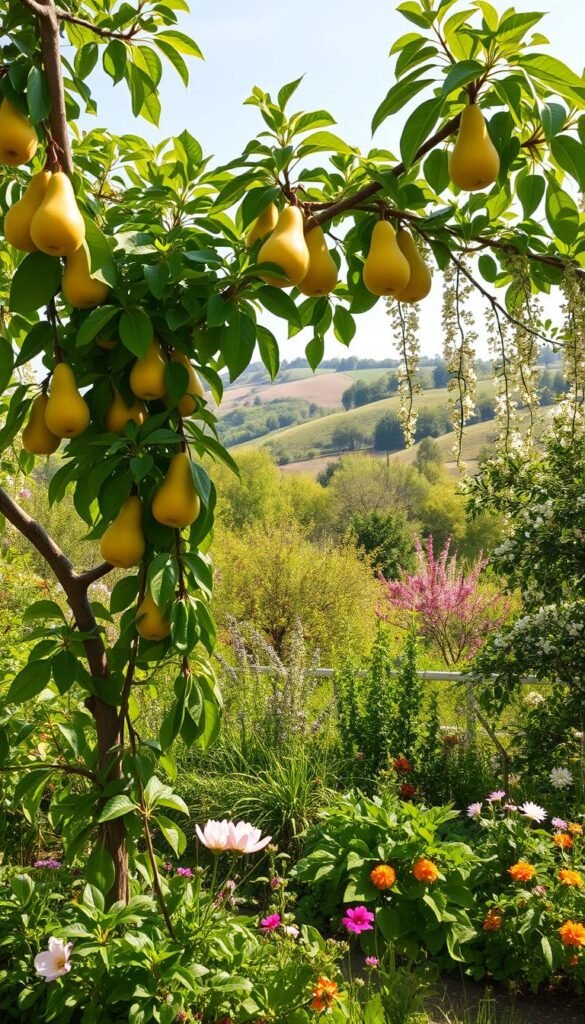
Transform your property into a thriving ecosystem where every plant plays multiple roles. This integrated method creates layers of beauty and utility, working together like pieces in nature’s puzzle.
Key Elements of an Integrated Approach
Start by building plant communities around your central specimens. These groupings handle soil health, pest control, and visual appeal simultaneously. Think of them as nature’s multitaskers.
Nitrogen-rich allies like comfrey boost fertility without chemicals. Their deep roots mine nutrients while their leaves create natural mulch. Pair them with fragrant herbs—lavender confuses pests, while thyme invites pollinators.
| Plant Type | Primary Role | Secondary Benefit |
|---|---|---|
| Comfrey | Soil enrichment | Weed suppression |
| Yarrow | Nutrient cycling | Drought resistance |
| Strawberry | Ground cover | Edible harvest |
Strategic ground covers like strawberries serve dual purposes. They carpet the soil to retain moisture while offering sweet rewards. For more edible landscaping design ideas, explore layouts that maximize space and productivity.
This approach reduces upkeep while increasing yields. Your space becomes a living classroom where beauty meets purpose—no synthetic inputs required.
Innovative Raised Beds and Herb Spirals for Visual Impact
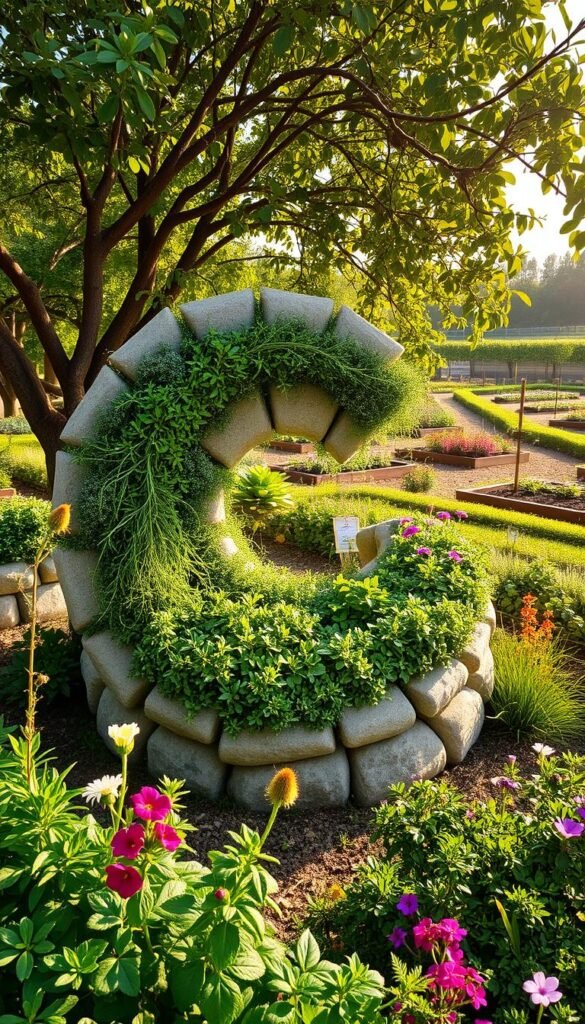
Elevate your outdoor design with vertical solutions that marry practicality and artistry. Raised beds and herb spirals solve small-space challenges while creating striking focal points. These structures turn cramped corners into productive displays where plants thrive at eye level.
Material Choices for Raised Beds
Selecting durable materials ensures your garden beds age gracefully. Cedar and redwood resist rot naturally, lasting over a decade without chemical treatments. Modern options like Cor-Ten steel develop rust-toned patinas that complement minimalist design schemes.
| Material | Key Benefit | Lifespan |
|---|---|---|
| Cedar | Natural rot resistance | 10-15 years |
| Stone-faced blocks | Weatherproof durability | 25+ years |
| Cor-Ten steel | Modern aesthetic | 20+ years |
Maximizing Space with Herb Spirals
Herb spirals pack 15+ varieties into 6 square feet through smart vertical stacking. The structure creates three microclimates: dry peaks for rosemary, moist bases for mint, and mid-zones for parsley. This space-saving technique turns unused patches into aromatic wonderlands.
Arrange thyme and sage at the sun-baked summit where water drains quickly. Reserve the shaded base for lemon balm, which spreads happily in damp soil. Curved stone walls retain heat, extending your growing season naturally.
Incorporating Edible Flowers and Companion Planting Techniques
Turn your landscape into a living palette where edible flowers and strategic partnerships boost both beauty and harvests. These methods transform ordinary plots into dynamic ecosystems buzzing with life and flavor.
Choosing Edible Flowers for Color and Flavor
Nasturtiums bring fiery orange blooms to salads with their peppery zing. Delicate violas add pastel hues to desserts, while calendula petals mimic saffron’s golden touch in soups. Borage’s star-shaped blue flowers attract bees and lend cucumber freshness to summer drinks.
Lavender sprigs elevate baked goods while perfuming the air. Squash blossoms shine in tempura dishes, their sunny yellow trumpets lasting just hours after picking. Mix these varieties to create edible rainbows that shift with the seasons.
Benefits of Companion Planting
Strategic pairings work like nature’s security system. Marigolds repel root-knot nematodes, while basil confuses aphids with its strong scent. Garlic planted near roses deters black spot disease naturally.
For fruit-bearing plants, try chives to discourage apple scab or yarrow to boost pollinators. Studies show these partnerships can increase yields by 18-25% over three years. Learn more about companion planting strategies that strengthen your green space through every season.
These techniques create self-sustaining spaces where beauty feeds both eyes and plates. Your outdoor area becomes a thriving network of mutual support—no chemicals required.

